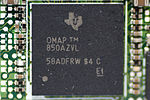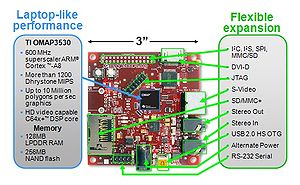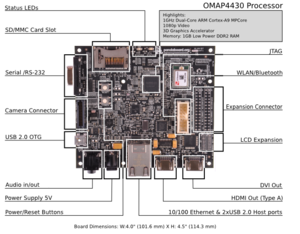- Texas Instruments OMAP
-
Texas Instruments OMAP (Open Multimedia Application Platform) is a category of proprietary system on chips (SoCs) for portable and mobile multimedia applications developed by Texas Instruments. OMAP devices generally include a general-purpose ARM architecture processor core plus one or more specialized co-processors. Earlier OMAP variants commonly featured a variant of the Texas Instruments TMS320 series digital signal processor.
Contents
OMAP family
The OMAP family consists of three product groups classified by performance and intended application:
- High-performance applications processors
- Basic multimedia applications processors
- Integrated modem and applications processors
Further, two main distribution channels exist, and not all parts are available in both channels. The genesis of the OMAP product line is from partnership with cell phone vendors, and the main distribution channel involves sales directly to such wireless handset vendors. Parts developed to suit evolving cell phone requirements are flexible and powerful enough to support sales through less specialized catalog channels; some OMAP 1 parts, and many OMAP 3 parts, have catalog versions with different sales and support models. Parts that are obsolete from the perspective of handset vendors may still be needed to support products developed using catalog parts and distributor-based inventory management.
Recently, the catalog channels have received more focus, with OMAP35x and OMAP-L13x parts being marketed for use with various applications where capable and power-efficient processors are useful.
High-performance applications processors
These are parts originally intended for use as application processors in smartphones, with processors powerful enough to run significant operating systems (such as Linux, Android or Symbian), support connectivity to personal computers, and support various audio and video applications.
OMAP 1
The OMAP 1 family started with a TI-enhanced ARM core, and then changed to a standard ARM926 core. It included many variants, most easily distinguished according to manufacturing technology (130 nm except for the OMAP171x series), CPU, peripheral set, and distribution channel (direct to large handset vendors, or through catalog-based distributors). In March 2009, the OMAP1710 family chips are still available to handset vendors.
Products using OMAP 1 processors include hundreds of cell phone models, and the Nokia 770 Internet tablets.
- OMAP171x - 220 MHz ARM926EJ-S + C55x DSP, low-voltage 90 nm technology
- OMAP162x - 204 MHz ARM926EJ-S + C55x DSP + 2 MB internal SRAM, 130 nm technology
- OMAP5912 - catalog availability version of OMAP1621 (or OMAP1611b in older versions)
- OMAP161x - 204 MHz ARM926EJ-S + C55x DSP, 130 nm technology
- OMAP1510 - 168 MHz ARM925T (TI-enhanced) + C55x DSP
- OMAP5910 - catalog availability version of OMAP 1510
OMAP 2
These parts were only marketed to handset vendors. Products using these include both Internet tablets and mobile phones:
- OMAP2431 - 330 MHz ARM1136 + 220 MHz C64x DSP
- OMAP2430 - 330 MHz ARM1136 + 220 MHz C64x DSP + PowerVR MBX lite GPU
- OMAP2420 - 330 MHz ARM1136 + 220 MHz C55x DSP + PowerVR MBX GPU
OMAP 3
The 3rd generation OMAP, The OMAP 3[1] is broken into 3 distinct groups: the OMAP34x, the OMAP35x, and the OMAP36x. OMAP34x and OMAP36x are distributed directly to large handset (such as cell phone) manufacturers. OMAP35x is a variant of OMAP34x intended for catalog distribution channels. The OMAP36x is a 45 nm version of the 65 nm OMAP34x with higher clock speed.[2]
The video technology in the higher end OMAP 3 parts is derived in part from the DaVinci product line, which first packaged higher end C64x+ DSPs and image processing controllers with ARM9 processors last seen in the older OMAP 1 generation or ARM Cortex-A8[3].
Not highlighted in the list below is that each OMAP 3 SoC has an "Image, Video, Audio" (IVA2) accelerator. These units do not all have the same capabilities. Most devices support 12 megapixel camera images, though some support 5 or 3 megapixels. Some support HD imaging.
Model number Semiconductor technology CPU instruction set CPU GPU Utilizing devices OMAP3410 65 nm ARMv7 600 MHz ARM Cortex-A8 PowerVR SGX530 Motorola Charm, Motorola Flipout, Motorola Flipside OMAP3420 65 nm ARMv7 600 MHz ARM Cortex-A8 PowerVR SGX530 OMAP3430 65 nm ARMv7 600 MHz ARM Cortex-A8 PowerVR SGX530 Motorola Droid/Milestone, Palm Pre, Samsung i8910, Nokia N900 OMAP3440 65 nm ARMv7 800 MHz ARM Cortex-A8 PowerVR SGX530 Motorola XT720, Archos 5 (Gen 7), Samsung SHW-M100S Galaxy A, Motorola Titanium XT800 OMAP3503 65 nm ARMv7 600 MHz ARM Cortex-A8 N/A Gumstix Overo Earth OMAP3515 65 nm ARMv7 600 MHz ARM Cortex-A8 PowerVR SGX530 OMAP3525 65 nm ARMv7 600 MHz ARM Cortex-A8 N/A OMAP3530 65 nm ARMv7 720 MHz ARM Cortex-A8 PowerVR SGX530 phyCARD-L System on Module, BeagleBoard, Gumstix, IGEPv2, Alico's Kinetic 3500,[4] OSWALD, Overo Water, Pandora, Touch Book, Embest DevKit8000, OpenSourceMID OMAP3611[5] 45 nm ARMv7 800 MHz ARM Cortex-A8 PowerVR SGX530 Cybook Odyssey OMAP3621(OMAP3622) 45 nm ARMv7 3621: 800 MHz, 3622: 1 GHz; ARM Cortex-A8 PowerVR SGX530 Nook Color, Nook Simple Touch OMAP3630 45 nm ARMv7 600 MHz~1.2 GHz ARM Cortex-A8 PowerVR SGX530 3630-800: Motorola Bravo, Motorola Defy;[6] 3630-1000: Nokia N9, Nokia N950, Motorola Milestone 2,Motorola Cliq 2, Motorola Defy+, Pre 2, Droid X, Droid 2, Archos 101, Archos 70, Archos 43, Archos 32, Archos 28, LG Optimus Black, LG Optimus bright L-07C, Samsung I9003 Galaxy S(C)L, LG-LU3000 Optimus Mach, Panasonic P-07C, Panasonic Sweety 003P
3630-1200: Motorola Droid 2 Global
OMAP 4
The 4th generation OMAPs, OMAP 4430, 4460 (formerly named 4440),[7] and 4470 all use dual-core ARM Cortex-A9s. The 4470 additionally contains two ARM Cortex-M3s running at 266 MHz to offload the A9s in less computionally intensive tasks to increase power efficiency.[8][9][10] 4430 and 4460 use a PowerVR SGX540 integrated 3D graphics accelerator which runs at a clock frequency of 304 and 384 MHz respectively compared to prior versions of SGX540 typically at 200 MHz making them theoretically much faster.[11] 4470 has a PowerVR SGX544 GPU that supports DirectX 9 which enables it for use in Windows 8 as well as a dedicated 2D graphics core for increased power efficiency. All OMAP 4 comes with an IVA3 multimedia hardware accelerator with a programmable DSP that enables 1080p Full HD and multi-standard video encode/decode.[12][13][14][15][16] OMAP 4 uses ARM-Cortex A9s with ARMs SIMD engine (Media Processing Engine, aka NEON) which may have a significant performance advantage in some cases over Nvidia Tegra 2s Cortex-A9s with non-vector floating point units.[17] It also uses a dual-channel LPDDR2 memory controller compared to Nvidia Tegra 2s single-channel memory controller.
Model number Semiconductor technology CPU instruction set CPU GPU Memory technology Availability Utilizing devices OMAP4430 45 nm ARMv7 1-1.2 GHz dual-core ARM Cortex-A9 PowerVR SGX540 @ 304 MHz Dual-channel LPDDR2 memory controller Q1 2011 phyCORE-OMAP4430 System on Module, PandaBoard, RIM BlackBerry Playbook[18], LG Optimus 3D P920, Motorola Droid/Milestone 3, Motorola Droid Bionic, Toshiba AT200 Excite, Fujitsu Arrows Tab LTE F-01D, Fujitsu Arrows Z ISW11F, Kindle Fire, Panasonic 101P, Sharp 102SH, Archos 101(Gen 9), Archos 80(Gen 9), Motorola Droid RAZR[19] OMAP4460 45 nm ARMv7 1.2-1.5 GHz dual-core ARM Cortex-A9 PowerVR SGX540 @ 384 MHz Dual-channel LPDDR2 memory controller Q4 2011 Galaxy Nexus, Archos 101 Turbo(Gen 9), Archos 80 Turbo(Gen 9), Sharp 104SH, Variscite VAR-SOM-OM44 System on Module OMAP4470 45 nm ARMv7 1.5-1.8 GHz dual-core ARM Cortex-A9 PowerVR SGX544 @ 384 MHz + dedicated 2D graphics core Dual-channel LPDDR2 memory controller, 466 MHz Q2 2012 OMAP 5
The 5th generation OMAP, OMAP 5 SoC uses a dual-core ARM Cortex-A15 CPU with two additional ARM Cortex-M4 cores to offload the A15s in less computionally intensive tasks to increase power efficiency, two PowerVR SGX544MP graphics cores and a dedicated TI 2D BitBlt graphics accelerator, a multi-pipe display sub-system and a signal processor.[20] They respectively support 24 and 20 megapixel cameras for front and rear 3D HD video recording. The chip also supports up to 8 GB of dual channel DDR3 memory, output to four HD 3D displays and 3D HDMI 1.4 video output. OMAP 5 also includes 3 USB 2.0 ports and a SATA 2.0 controller.
Model number Semiconductor technology CPU instruction set CPU GPU Memory technology Availability OMAP5430 28 nm ARMv7 2 GHz dual-core ARM Cortex-A15 Dual-core PowerVR SGX544MP + dedicated 2D graphics accelerator Dual-channel package on package LPDDR2 Q3 2012 OMAP5432 28 nm ARMv7 2 GHz dual-core ARM Cortex-A15 Dual-core PowerVR SGX544MP + dedicated 2D graphics accelerator Dual-channel DDR3 controller Q3 2012 Basic multimedia applications processors
These are marketed only to handset manufacturers. They are intended to be highly integrated, low cost chips for consumer products. The OMAP-DM series are intended to be used as digital media coprocessors for mobile devices with high megapixel digital still and video cameras.
- OMAP331 - ARM9
- OMAP310 - ARM9
- OMAP-DM270 - ARM7 + C54x DSP
- OMAP-DM299 - ARM7 + ISP + stacked mDDR SDRAM
- OMAP-DM500 - ARM7 + ISP + stacked mDDR SDRAM
- OMAP-DM510 - ARM926 + ISP + 128 MB stacked mDDR SDRAM
- OMAP-DM515 - ARM926 + ISP + 256 MB stacked mDDR SDRAM
- OMAP-DM525 - ARM926 + ISP + 256 MB stacked mDDR SDRAM
Integrated modem and applications processors
 An OMAP 850 in a HTC Wizard
An OMAP 850 in a HTC Wizard
These are marketed only to handset manufacturers. Many of the newer versions are highly integrated for use in very low cost cell phones.
- OMAPV1035 - single-chip EDGE (was discontinued in 2009 as TI announced baseband chipset market withdrawal).
- OMAPV1030 - EDGE digital baseband
- OMAP850 - 200 MHz ARM926EJ-S + GSM/GPRS digital baseband + stacked EDGE co-processor
- OMAP750 - 200 MHz ARM926EJ-S + GSM/GPRS digital baseband + DDR Memory support
- OMAP733 - 200 MHz ARM926EJ-S + GSM/GPRS digital baseband + stacked SDRAM
- OMAP730 - 200 MHz ARM926EJ-S + GSM/GPRS digital baseband + SDRAM Memory support
- OMAP710 - 133 MHz ARM925 + GSM/GPRS digital baseband
OMAP L-1x
The OMAP L-1x parts are marketed only through catalog channels, and have a different technological heritage than the other OMAP parts. Rather than deriving directly from cell phone product lines, they grew from the video-oriented DaVinci product line by removing the video-specific features while using upgraded DaVinci peripherals. A notable feature is use of a floating point DSP, instead of the more customary fixed point one.
The Hawkboard uses the OMAP-L138
- OMAP-L137 - 300 MHz ARM926EJ-S + C674x floating point DSP
- OMAP-L138 - 300 MHz ARM926EJ-S + C674x floating point DSP
Products using OMAP processors
Many mobile phones use OMAP SoCs, including the Nokia N90, N91, N92, N95, N82, E61, E62, E63, E90, N800, N810 and N900 Internet tablets, Motorola Droid, Droid X, and Droid 2. The Palm Pre, Pandora, Touch Book also use an OMAP SoC (the OMAP3430). Others to use an OMAP SoC include the Sony Ericsson Satio, the Sony Ericsson Vivaz, the Samsung Omnia HD, Sony Ericsson Idou, the Nook Color, Kindle Fire, and some Archos tablets (such as Archos 80 gen 9 and Archos 101 gen 9).
OMAP SoCs are also used as the basis for a number of hobbyist and prototyping boards, such as the Beagle Board and Panda Board.
Similar platforms
- Snapdragon by Qualcomm
- Tegra by Nvidia
- Samsung (System on Chip)
- Apple Ax (System on Chip)
References
- ^ OMAP34xx series in TI Web site
- ^ OMAP36x
- ^ http://www.ti.com/product/dm3730
- ^ http://www.alicosystems.com/Alico%20FSDK%203500%200311A.pdf
- ^ The 3611 is the same die as 3621 but with restricted access to the DSP part
- ^ http://focus.ti.com/pdfs/wtbu/OMAP36xx_ES1.x_PUBLIC_TRM_vN.zip
- ^ http://www.linuxfordevices.com/c/a/News/Variscite-VARSOMOM44/ Computer module taps 1.5GHz, dual-core OMAP4460 SoC
- ^ http://focus.ti.com/pdfs/wtbu/OMAP4430_ES2.x_Public_TRM_vK.zip
- ^ "OMAP4460 Public TRM vE (pdf)"
- ^ http://www.engadget.com/2011/06/02/texas-instruments-announces-multi-core-1-8ghz-omap4470-arm-proc/
- ^ http://www.anandtech.com/show/4413/ti-announces-omap-4470-and-specs-powervr-sgx544-18-ghz-dual-core-cortexa9
- ^ OMAP44xx series in TI Web site
- ^ http://www.linuxfordevices.com/c/a/News/TI-OMAP4430-and-OMAP4440/ TI speeds up its OMAP 4 for 3D video
- ^ http://www.engadget.com/2010/02/02/tis-omap4-prototype-drives-three-independent-displays-without-b/ TI's OMAP 4 prototype drives three independent displays without breaking a sweat
- ^ http://www.engadget.com/2009/02/17/tis-omap-4-bringing-1080p-support-to-smartphones-and-mids/ TI's OMAP 4 bringing 1080p support to smartphones and MIDs
- ^ http://www.engadget.com/2010/02/15/texas-instruments-introduces-arm-based-omap-4-soc-blaze-develop/ Texas Instruments introduces ARM-based OMAP 4 SOC, Blaze development platform
- ^ http://www.anandtech.com/show/4098/nvidias-tegra-2-take-two-more-architectural-details-and-design-wins/2
- ^ http://www.telegraph.co.uk/technology/blackberry/8400612/Blackberry-confirms-PlayBook-specs-and-launch-date.html
- ^ http://developer.motorola.com/products/droid-razr-xt912/
- ^ "Not Just a Faster Horse: TI’s OMAP 5 Platform Transforms the Concept of ‘Mobile’". Texas Instruments. 11-02-07. http://newscenter.ti.com/Blogs/newsroom/archive/2011/02/07/not-just-a-faster-horse-ti-s-omap-5-platform-transforms-the-concept-of-mobile-615064.aspx. Retrieved 2011-02-09. "The OMAP 5 processor leverages two ARM Cortex-A15 MPCores [...] [It] also includes two ARM Cortex-M4 processors [...]"
External links
Categories:- Embedded microprocessors
- Digital signal processors
- ARM architecture
- Texas Instruments hardware
Wikimedia Foundation. 2010.


